Martin Firrell
| Martin Firrell | |
|---|---|
 Photographic self portrait of Public Artist Martin Firrell created March 2016 | |
| Occupation | writer, public artist, campaigner |
| Nationality | British |
| Period | 1996 – present |
| Notable works | The Question Mark Inside, St Paul's Cathedral, Complete Hero with the Household Division of the British Army |
| Spouse | Moon Laramie (2013 – present) |
| Website | |
|
www | |

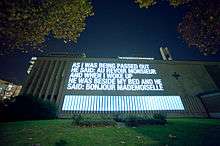
Martin Firrell (born 4 April 1963, Paris, France)[1] has been described variously as a cultural activist, a campaigner,[2] a public artist, or benevolent provocateur, stimulating debate in public space to promote positive social change.
Firrell has raised questions about the politics of ageing, individual liberty, the right to personal idiosyncrasy, cultural diversity, gender equality, faith, climate change, masculinity, what constitutes a meaningful and purposeful life, hero worship, fair and truthful government, and the quality of human lived experience.
His work has been summarised as 'art as debate'.[3]
Early life
Firrell was educated in England but left school unofficially at 14[4] because he “had no more use for it”. He educated himself during his absence from school by walking and reading in the Norfolk countryside. He read early 20th century-literature extensively, citing the works of Virginia Woolf, Gertrude Stein, and the French writer Marguerite Duras (with whom he shares his birthday and a high degree of political sympathy) as key influences on his later development.
It was a passage in Anaïs Nin's novel The Four Chambered Heart that set Firrell on the path of socially engaged public works. In the passage in question, the novel's protagonist declares that literature fails to prepare us for, or guide us through, the calamities or challenges of life, and is therefore worthless.
“In a very early work, (The Beautiful and The Grave, Providence Press, published 1992) almost twenty years ago, I wrote that art should be a force for good, and I have stuck faithfully to that premise. As I have grown older I have become more adamant that my purpose is to campaign in some way for change, using my works as a medium for catalysing debate. If you can raise debate, eventually change will follow."[5]
Firrell sets out to remedy Nin’s ‘worthlessness’ of words by using language to raise provocative questions about society, relevant to the vast majority of people and freely available in public.[6]
Firrell trained originally as an advertising copywriter.[7]
Practice


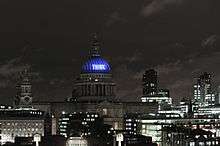

In most of Firrell's works it becomes apparent that uppermost is the belief in the redemptive power of ideas, directed at extending or protecting the right of the individual to create his or her own unique way of life and to live it accordingly without interference.[8]
Consistent with this aim is a greater emphasis on participation in recent works. Complete Hero invited the contribution of ideas, experiences and opinions which formed the greater proportion of the project as it evolved on the internet.[9]
Firrell has held that the purpose of existence is to develop the richness and meaning of lived experience, that art and culture in general should be key contributors to this central project and that their success or otherwise can be measured against this criterion.[10]
In the Sky Arts documentary, The Question Mark Inside, Firrell discussed his view that contemporary art has lost its way, serving a self-elected elite, rather than the wider interests of humanity. He further claimed that art's proper place is at the centre of everyday life as a powerful force for good, that it should be a joyous expression of our shared humanity, and that his personal motto is "why settle for the art world when you can have the whole world?" [11]
Royal Opera House Creative Director Deborah Bull said of Firrell, "Yes he's a provocateur if you like, but the underlying message is very rarely 'life's rubbish and you're all a bunch of sharks'.... He's seeking to move beyond simple messages to something which provokes in the viewer a new sense of themselves and their place in the world".[12]
On the same topic, Firrell has said: "I felt there was a problem with writing because of narrative – because it unfolds in time necessarily, and I was jealous of the painters where everything in painting is available in a single field. Simply, I wanted to make words work like a picture and that led me to writing aphorisms. When I wrote All Men Are Dangerous,[13] I wrote something of immense truthfulness and importance with all of its meaning entirely available in a single field."
Firrell has used cinema screens, newsprint, the internet, portraiture and video interviews of culturally significant figures like Howard Jacobson, April Ashley, Johnson Beharry VC, and A C Grayling, and large-scale digital projection onto the Guards Chapel, spiritual home of the Household Division of the British Army,[14] the National Gallery in London,[15] the Houses of Parliament, the Royal Opera House, Covent Garden,[16] Tate Britain,[17] and St Paul's Cathedral.[18]
Firrell has worked with complex and influential organisations including the Church of England (St Paul's Cathedral 2008) and The British Army (Household Division 2009). Canon Martin Warner, commissioner of Firrell's work for St Paul's stated in the cathedral's 2008 Annual Report that Firrell possesses "a genius for creating partnerships".[19] Arguably, it's this ability that has enabled organisations to engage confidently with audacious, self-questioning project content including "I don't think this is what God intended" (West Front, St Paul's Cathedral) and "War is always a failure" (North elevation, Guards Chapel).
Firrell allowed cameras to record his creative process for the first time in 2008. The Question Mark Inside,[20] a television documentary produced by Simon Channing Williams and Colin Burrows was first broadcast by Sky Arts 1 on 29 October 2009, and provided new insights into Firrell's opinions, aims, daily life and practice.
Firrell's body of work includes investigations into portraiture (Text Portrait of Howard Jacobson, Booker Prize winner, 2010) and explorations of the power of mass popular culture to propagate socially useful ideas, in particular, the science fiction genre.[21]
In 2006, The Guardian described Firrell as 'One of the capital's most influential public artists'.[22]
Writing in The Independent, Howard Jacobson stated, "I like words on public buildings and Firrell is a master at gauging their power."[23]
Caitlin Moran for The Times described Firrell's work as being built on "huge, open-chord statements that make your ears ring".[24]
Firrell was born in Paris, unexpectedly, on the Champs-Élysées outside what is now Sephora. He lives and works in Soho, London and a large proportion of his work is created at Soho café, Cafe Gourmand, which acts as his "studio, canteen and campaign HQ".
Firrell is also London Cultural Ambassador for the International Herald Tribune and he curated the newspaper's first London Arts Season in 2005, titled 'Breathless…' after Jean-Luc Godard's nouvelle vague film of the same title.[25]
Popular culture



Firrell has declared his belief that mass, rather than high, culture may well be the more powerful shaper of our ideas about how to live rich and fruitful lives.
Metascifi (iOS app published 4 April 2015)[26] mines popular American television science fiction for helpful ideas and philosophical truths with direct bearing on the project of enriching lived experience.[27]
Contributors include Kate Mulgrew (aka Captain Kathryn Janeway, Star Trek Voyager), Joe Flanigan (aka Colonel John Sheppard from Stargate Atlantis), Torri Higginson (aka Dr Elizabeth Weir, Stargate Atlantis), Ben Browder (aka Commander John Crichton, Farscape).
Interviewed by SFX Magazine in January 2011, Firrell stated, "I am interested in the power of popular culture to disseminate sound ideas about how to live productive, intriguing and valuable lives. It struck me that popular culture is often looked down on by 'serious' critics or commentators. I wanted to use my privileged position as an artist to counter this by taking a very long, deep and critical view of the ideas in science fiction and their potential value when applied to our daily lives.
"Truth is, I have little or no idea about how to live a good life myself, and my experience suggests that we are all equally baffled and all equally in need of ideas and advice. Science Fiction is as good as source as any, in my opinion – maybe a better source than most. So the Sci Fi Series project is intended to create a platform for thinking about what might be important and helpful to us all."[28]
It Ends Here (2014) was commissioned by Twentieth Century Fox Film Company to coincide with the release of the eighth film in the Planet of the Apes franchise, Dawn of the Planet of the Apes.
Firrell said his intention was to explore the deeper value of Planet of the Apes’ particular corner of pop culture, locating truths that cast light on our attempts to live humanely in an over-crowded and tension-filled world” [29]
The project extended Firrell’s interest in ‘mining popular culture for quite serious content’ [30]
Firrell created five different underground environments in the Vaults under London’s Waterloo Station, each dominated by a word or phrase: words stand tall as a man in pitch-blackness; the underground spaces rumble with found sound’. Visitors are given torches to explore and discover texts.[31]
It Ends Here constituted a new development in Firrell’s practice deploying live performers in theatrical environments for the first time. The overall ambience looks to put visitors’ minds ‘in a state of alert’, said Dr Melanie Vandenbrouck, curatorial advisor on the project.[32]
Metaworks



Metafenella is the first release in a planned series of metaworks including Metascifi.
Metafenella is an interactive video portrait offering advice for living well from the life and work of actress Fenella Fielding, England's First Lady of the double entendre. Video portraiture draws out life lessons from Fielding's roles as the vampiric Valeria Watt in Carry On Screaming, as Herself and Lady Hamilton in The Morecambe and Wise Show, and as The Voice in the cult TV series The Prisoner.
The macro objective of metaworks like Metafenella and Metascifi is to derive resonant truths from popular culture and to make them easily applicable to everyday life. Through self-reference, these metaworks illuminate, and extemporise on, the deep value that can be inferred from popular culture, and re-present that value as a series of viable and practical strategies for navigating contemporary life.[33]
"I try to affect the texture of the moment because the only thing we can be sure of is this actual moment in our lives."[34]
Early works
Two early works point to the agenda Firrell has explored extensively in mature works. Lucid Between Bouts of Sanity, published in a tri-lingual edition in 1996, is a manifesto in four sections exploring the reductive nature of action, the flaws in language, the difficulty of meaning anything accurately to anyone, and the possibility of using a constrained and reduced language to find a new expressive power. "I felt it must be possible to describe the limits within which all language must operate and so designate a clearly defined space for my own experimentation."[35]
The manifesto was published in French, English and Russian and distributed at the ICA Cafe in London and the Literaturnaya Cafe in St Petersburg.
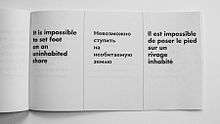
Postcards 1998 is an early, and now extremely rare, print project of 14 postcards in a green card slipcase. The project consists of 13 texts presented where postcards customarily display a picture, and a 14th card showing a photographic portrait of the artist (taken by Russian Concert Pianist, Yekaterina Lebedeva, using a disposable camera) on the Pont des Arts in Paris, mid cartwheel. It was the first of Firrell's works conceived with the sole aim of having a direct presence and influence in people's daily lives.
"I wanted to make a work that could be pinned up in the family kitchen because it spoke to a family member in some personal and significant way. I wanted to explore the possibilities of being more deeply implicated in life."
This project can be regarded as a working prototype with influence over all subsequent works including large-scale projections of text in public space and works investigating the deep value of mass popular culture.[36]
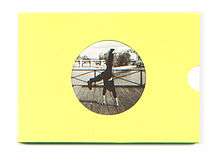
Cafes
Quoted in the Independent on Sunday, 18 April 2004, Firrell declared that "revolutions have always started in cafes". Accordingly, Patisserie Maison Bertaux, owned by sisters Michele and Tania Wade, served as Firrell's studio and poste restante between 2002 and 2009, and the Wades described Firrell as their permanent artist in residence. The majority of Firrell's works of that period were created in the little upstairs tea room where 'hooligan art dealer' Tania Wade also shows artists' work.[37]
From mid 2013, Firrell relocated to Cafe Gourmand at 53 Lexington Street. Firrell's working method is founded on writing a journal daily which "acts as a net" catching the development of his ideas and tracking evolving trains of creative thought. As a project matures, Firrell switches to the use of small pieces of paper: individual statements or visual elements are printed on separate paper slips and laid out in a variety of combinations before Firrell decides on the final structure of the work to be digitally mastered.
Of starting most days at Cafe Gourmand, Firrell has written: 'Starting the day at (Cafe) Gourmand brings me into contact with strangers, speaks to an idea of Parisian heritage, provides breakfast and a period of reflection and self-examination before the practicalities of running a practice take over. I work primarily on a laptop these days (though previously I had used paper cut into small strips to marshal text) because the current works in progress – the Metaworks – require video and sound editing.' [38]
Residencies


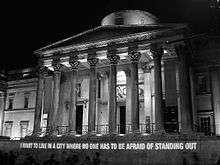

Firrell has worked with large institutions that are not customarily associated with bold or controversial public statements. Firrell was Public Artist in Residence with the Household Division of the British Army in 2009, developing Complete Hero for projection onto the Guards Chapel in November 2009.[39]
Complete Hero explored and celebrated contemporary ideas of heroism based on interviews with members of the Household Division and wider Army who have experience of active service including Lance Corporal Johnson Beharry VC; with writers, thinkers and performers including actor Nathan Fillion speaking of the contemporary male hero in cult popular culture,[40] novelist Howard Jacobson and writer Adam Nicolson speaking of the hero in literature, with the iconic writer and speaker April Ashley, comedian Shazia Mirza, and philosopher A C Grayling.
Members of the public contributed their own views of the meaning and significance of heroism in their lives at the Complete Hero blog.[41]
In 2008, Firrell was Public Artist in Residence at St Paul's Cathedral. The residency culminated in The Question Mark inside, digital text projections based on blog contributions from members of the public,[42] interviews conducted by the artist with some of the UK's most respected thinkers, and the artist's own observations.
Commissioned by Dean and Chapter of St Paul's to celebrate the 300th anniversary of the topping-out of Christopher Wren's cathedral building, the project aimed to answer the questions: “what are the things that make like meaningful and purposeful, and what does St Paul's Cathedral mean in that contemporary context?”[43]
A stream of possible answers, from the domestic to the sublime, appeared as text projections onto the south elevation of the cathedral dome, the West Front at Ludgate Hill and inside onto the Whispering Gallery. Comments about these projections can be posted on the project blog.[44]
Whilst the means and aesthetics may be very different, Firrell's works can be regarded as the logical descendants of paintings like Delacroix's Liberty Leading the People.
Motifs and recurring themes
Several themes and campaign positions recur in Firrell's works: a plea for the value of things that are different and the point of view that what is different should be investigated for potential rather than rejected as ‘other’ or perceived with suspicion or fear (Celebrate Difference, LED screen, Leicester Square 2001; Different Is Not Wrong, Curzon Cinemas 2006-7; I Want To Live In A City Where People Who Think Differently Command Respect, The National Gallery, London 2006). Firrell has also consistently campaigned for gender equality and from what is customarily regarded as a feminist position (I Want To LIve In A City Where Half The People In Charge Are Women, The National Gallery, London 2006; Why Are Women Still Discriminated Against? The Question Mark Inside, St Paul’s Cathedral, London 2008); Women Are Much More Honourable Than Men, quoting April Ashley, Complete Hero, Guards Chapel, London 2009). The subjects of maleness, violence and war tend to appear in association with one another; war is often commented upon but not necessarily from a purely pacifist perspective (All Men Are Dangerous, War Is A Male Preoccupation, Keep The Faith, Tate Britain 2006; I Don’t Understand Why There Is War, The Question Mark Inside, St Paul’s Cathedral, London 2008; War Is Always A Failure, Complete Hero, Guards Chapel, London 2009).[45]
The majority of Firrell's works include some form of ancillary visual motif. Most common are vertical lines, either scrolling from left to right, or presented as static fields in 'agitated motion'. Vertical lines are used to back, or underscore text, or to reveal and obscure text. Customarily the lines have been presented as white light. This vertical line motif appeared in every work between 2006 and 2010 with the exception of I Want To Live in a City Where... (The National Gallery, London 2006).[46]
In a 2014 interview for the bureau of sensory intelligence, Firrell responded to the question, 'What qualities do you most admire in an object' with the statement, 'Its power to provoke; economy of means; symmetry; the colour blue; text; an insistence (implied or inferred) on justice.' This 'object', so described, bears a striking resemblance to Firrell's own works of public art, and can be seen to constitute a summary manifesto for the making and showing of work in public space – blue light featured strongly in Firrell's 300th anniversary commission for St Paul's Cathedral, and simplicity, symmetry, and clearly defined political positions are hallmarks of the majority of his works.[47]
Firrell has also used what he has described (in the Sky Arts documentary, The Question Mark Inside) as 'Easter Island heads' – images of Buddha and Hanuman (Keep The Faith, Tate Britain, London 2006) and recently most notably of Canadian actor Nathan Fillion (Complete Hero, Guards Chapel, London 2009). The use of Fillion's likeness was augmented by those of other contributors including Dr Adam Rutherford, April Ashley, Professor A C Grayling and Lance Corporal Johnson Beharry VC.
The 'Easter Island Head' motif is revisited and extended in Metascifi (iOS app, 2015).[48] Video portraits of performers who are influential in that subculture express the sociological and philosophical significance of the dramas they have played out in their respective television franchises. "I aimed for extreme simplicity and a tacit monumentality, like the heads of Easter Island. The aesthetic problem was always one of portraiture – how do you make portraiture of these incredible performers (and by extension of the characters they have created) that has a clear point of view, a visual strength and distinctiveness?"
Notable projects
- Metascifi iOS app / video portraiture / digital documentary, philosophical truths derived from popular American television science fiction, feat. Ben Browder, Nathan Fillion, Joe Flanigan, David Hewlett, Torri Higginson, Christopher Judge, Eddie McClintock, Kate Mulgrew, David Nykl et al 2015 [49]
- It Ends Here installed text, haze, coloured light, found sound, performers / human nature or the road to redemption or hell, The Vaults, Waterloo Station, London 2014
- Metafenella interactive video portraiture / advice for living well from the life and work of British actress Fenella Fielding 2014[50]
- Complete Hero largescale digital projections to the North and West elevations of the Guards Chapel, Birdcage Walk, London with Nathan Fillion, April Ashley, Howard Jacobson, Adam Nicolson, Johnson Beharry VC, A C Grayling, Wezley Sebastian, Gia Milinovich, Mo Blackwood, Shazia Mirza, Dr Adam Rutherford, Dr Jennifer Rohn et al 2009[51]
- St Paul's Cathedral The Question Mark Inside commissioned by Dean and Chapter to celebrate the 300th anniversary of the topping-out of Christopher Wren's cathedral building. Digital text projections to the cathedral dome, West Front and Whispering Gallery, London 2008[52]
- Curzon Cinemas 1968 (digital projections to mark the 40th anniversary of May 1968 for the festival All Power to the Imagination: 1968 and its Legacies) 2008[53]
- Hamlyn Foundation/Royal Opera House Power is always temporary (digital projection to the Royal Opera House main stage) 2007[54]
- Royal Opera House It's Passion that Binds Us… (digital projection onto the Covent Garden elevation of the Royal Opera House) 2007[55]
- Curzon Cinemas Different is not Wrong (35 mm projection, cinema screens) 2006-7[56]
- Campaign against Climate Change How ironic to live in fear of terrorism and die because of climate change (xenon projection to St Pancras Station, Battersea Power Station and Parliament) 2006
- National Gallery, London I want to live in a city where… (digital projection onto the Trafalgar Square elevation of the National Gallery in London,[57]
- The Guardian When the world's run by fools it's the duty of intelligence to disobey (projection onto Parliament) 2006[58]
- Tate Britain All men are dangerous (words of wisdom projected onto the Duveen Gallery walls, commissioned by Amy Lamé for Duckie) 2006[59]
References
- ↑ Creative Review, One to Watch. London: Centaur Publishing, 2005, Vol. 25 Issue 1, p18.
- ↑ "Alex Hudson, BBC News". 21 October 2009. Retrieved 12 May 2010.
- ↑ "Public artist Martin Firrell presents It Ends Here - a new installation, Creative Review". London. 7 July 2014. Retrieved 11 October 2014.
- ↑ Creative Review, One to Watch. London: Centaur Publishing, 2005, Vol. 25 Issue 1, p18.
- ↑ The Independent on Sunday, There's a Revolution Brewing. London: Independent Print Ltd, 18 April 2004, p37
- ↑ "Forma Art Producers: Martin Firrell Biography".
- ↑ Creative Review, One to Watch. London: Centaur Publishing, 2005, Vol. 25 Issue 1, p18.
- ↑ "Cognitive Dissonance by Rick Poynor".
- ↑ "Complete Hero, Creative Review".
- ↑ Creative Review, One to Watch. London: Centaur Publishing, 2005, Vol. 25 Issue 1, p18.
- ↑ "Sky Arts, The Question Mark Inside".
- ↑ "Sky Arts, The Question Mark Inside".
- ↑ "Keep the Faith, Tate Britain".
- ↑ "Complete Hero, Creative Review".
- ↑ "Projections at the National Gallery: London Mayoral Office Press Release".
- ↑ "Projections at the Royal Opera House: Production Company Notes".
- ↑ "Projections at Tate Britain: Tate Website".
- ↑ "The Question Mark Inside at St Paul's Cathedral: Tate Modern Website".
- ↑ "Canon Martin Warner, St Paul's Cathedral Annual Report 2008".
- ↑ "Sky Arts, The Question Mark Inside".
- ↑ "The Art and Philosophy of Star Trek and Stargate, SFX Magazine". London. 18 January 2011. Retrieved 20 March 2011.
- ↑ The Guardian, Op-Art. London: Guardian Media Group, 22 July 2006, p33
- ↑ "Howard Jacobson, The Independent". London. 3 March 2007. Retrieved 12 May 2010.
- ↑ "Caitlin Moran, The Times". London. 18 June 2007. Retrieved 12 May 2010.
- ↑ "International Herald Tribune Moving Image Work for Breathless".
- ↑ "Metascifi, iTunes Store".
- ↑ "Sky Arts, The Question Mark Inside".
- ↑ "The Art and Philosophy of Star Trek and Stargate, SFX Magazine". London. 18 January 2011. Retrieved 20 March 2011.
- ↑ "Dawn of the Planet of the Apes inspires London art exhibition, Telegraph". London. 10 July 2014. Retrieved 11 October 2014.
- ↑ "Planet Of The Apes inspires artist's Waterloo installation, London Evening Standard". London. 26 June 2014. Retrieved 11 October 2014.
- ↑ "Public artist Martin Firrell presents It Ends Here - a new installation, Creative Review". London. 7 July 2014. Retrieved 11 October 2014.
- ↑ "It Ends Here, What's On, Design Week". London. 9 July 2014. Retrieved 11 October 2014.
- ↑ "Metafenella 2014". London. Retrieved 30 January 2014.
- ↑ "Creative Living London". London. 2013. Retrieved 31 January 2014.
- ↑ "Official website – Literaturnaya Cafe 1996".
- ↑ "Official website – Postcards 1998".
- ↑ "Tania Wade Hooligan Art Dealer".
- ↑ "Martin Firrell, official site". 10 March 2014. Retrieved 17 March 2014.
- ↑ "Complete Hero, Creative Review".
- ↑ "Local Star to be Face of Modern Hero, Edmonton Journal, Canada".
- ↑ "Complete Hero Project Blog".
- ↑ Martin, Francesca (30 January 2008). "Guardian Newspaper: Call for St Paul's Blog Contributions". The Guardian. London. Retrieved 12 May 2010.
- ↑ "St Paul's Cathedral: Question Mark Inside archive".
- ↑ "Projections at St. Pauls". 12 October 2008. Retrieved 10 December 2008.
- ↑ "Sky Arts, The Question Mark Inside".
- ↑ "Sky Arts, The Question Mark Inside".
- ↑ "Dressing the Air – Martin Firrell". London. Retrieved 14 April 2014.
- ↑ "Metascifi, iTunes Store".
- ↑ "Metascifi, iTunes Store".
- ↑ "metaFenella – interactive digital portrait". London. Retrieved 12 June 2014.
- ↑ "Complete Hero, Creative Review".
- ↑ The Oxford Dictionary of Christian Art and Architecture. Oxford University Press, 2008, p. 105.
- ↑ "All Power to the Imagination, 1968 and its Legacies, Season Programme" (PDF).
- ↑ "Royal Opera House: Performance Review 2006-7" (PDF).
- ↑ "Projections at the Royal Opera House: Production Company Notes".
- ↑ "Cognitive Dissonance by Rick Pynor".
- ↑ "Projections at the National Gallery: London Mayoral Office Press Release".
- ↑ The Guardian, Op-Art. London: Guardian Media Group, 25 February 2006, p. 29.
- ↑ "Projections at Tate Britain: Tate Website".
External links
| Wikiquote has quotations related to: Martin Firrell |
- Official page
- Martin Firrell at IMDb
- Martin Firrell at Twitter
- Metascifi, a practical guide to life inspired by the commanders, diplomats, scientists and aliens of American television science fiction
- Complete Hero
- metaFenella, interactive video portrait 2014
- Documentary: Art in a Word by Vera Baghiroli, Qoob tv